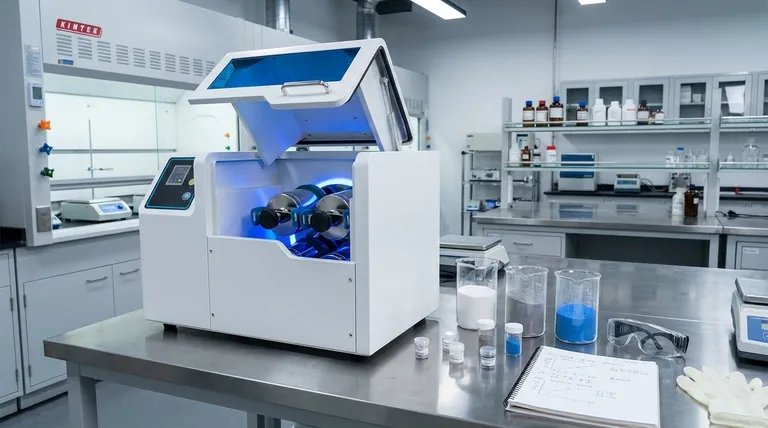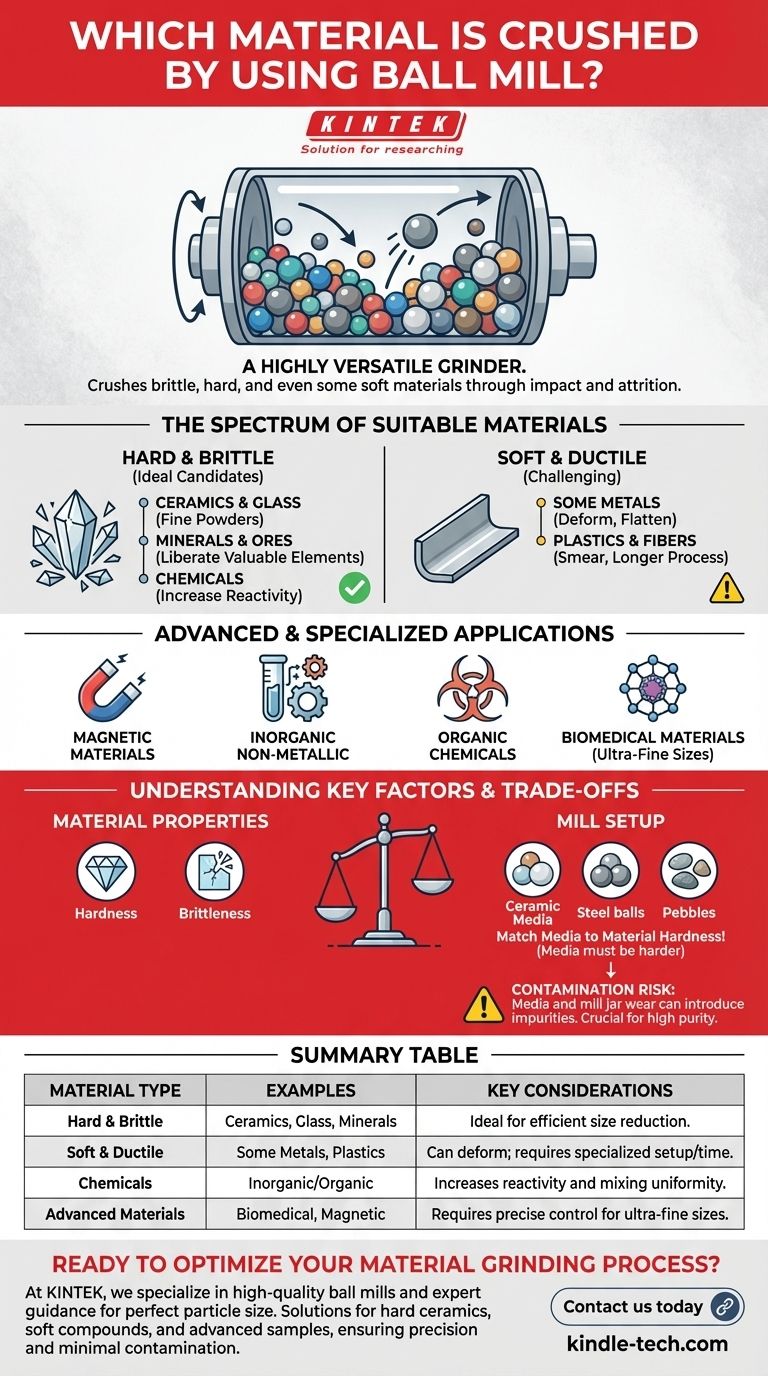In short, a ball mill is a highly versatile grinder used to crush or pulverize a vast range of materials. Its capabilities extend from hard, brittle substances like ceramics, glass, and minerals to softer materials, chemicals, and even advanced biomedical compounds. The machine is not limited to a single class of material but is defined by its ability to reduce particle size through impact and attrition.
The core principle is that a ball mill can process nearly any material that is brittle or can be made brittle. Its effectiveness is less about the specific material type and more about matching the mill's configuration—such as the grinding media—to the material's physical properties.

The Principle of Versatility: How Ball Mills Work
A ball mill operates by rotating a cylinder containing the material to be ground along with grinding media, such as ceramic or steel balls. As the cylinder turns, the media is lifted and then cascades or falls, crushing and grinding the material through impact and abrasion. This simple, powerful mechanism is why it can be applied to so many different substances.
The Spectrum of Suitable Materials
A ball mill's design allows it to handle materials with widely different characteristics. Samples can be soft, elastic, fibrous, hard, or brittle, making it one of the most adaptable grinding tools available in a laboratory or industrial setting.
Common Industrial and Laboratory Uses
The most frequent applications involve materials that fracture upon impact. This includes a wide array of inorganic substances used in research and manufacturing.
Key examples include:
- Ceramics and Glass: For creating fine powders used in advanced materials.
- Minerals and Ores: A standard step in mineral processing to liberate valuable elements.
- Chemicals: For reducing particle size to increase reactivity or improve mixing.
Advanced and Specialized Applications
Modern iterations like nano ball mills have expanded the tool's use into high-tech fields. These advanced mills can process specialized materials for cutting-edge applications.
This includes magnetic materials, inorganic non-metallic materials, organic chemicals, and even biomedical materials where precise, ultra-fine particle sizes are critical.
Understanding the Key Factors and Trade-offs
While highly versatile, a ball mill's success depends on understanding the interplay between the material's properties and the mill's setup. Simply putting any material inside is not a guarantee of success.
Material Hardness and Brittleness
Hard and brittle materials are the ideal candidates for ball milling. They shatter efficiently under the repeated impacts of the grinding media, allowing for predictable and effective size reduction.
The Challenge of Ductile Materials
Extremely soft or ductile materials, like some metals, can be problematic. Instead of fracturing, they may deform, flatten, or smear onto the grinding media and the mill's interior, hindering the grinding process.
The Critical Choice of Grinding Media
The material used for the grinding balls is crucial. The choice—typically ceramic balls, flint pebbles, or stainless steel balls—must be harder than the material being ground to be effective.
The Risk of Contamination
A significant trade-off is the potential for contamination. The grinding media and the mill jar itself can wear down during processing, introducing small amounts of their own material into the sample. This is a critical consideration for high-purity applications.
Making the Right Choice for Your Material
To determine if a ball mill is the correct tool, consider your material's properties and your final goal.
- If your primary focus is grinding hard, brittle materials (ceramics, ores, glass): A ball mill is an industry-standard, highly effective choice for producing a fine powder.
- If your primary focus is processing soft or fibrous materials: A ball mill can work, but you may need specialized configurations or longer processing times to achieve the desired result.
- If your primary focus is purity and avoiding contamination: You must carefully match the grinding media material to your sample to minimize unwanted impurities.
Ultimately, a ball mill's power lies in its adaptability, making it a cornerstone of particle size reduction for countless materials across science and industry.
Summary Table:
| Material Type | Examples | Key Considerations |
|---|---|---|
| Hard & Brittle | Ceramics, Glass, Minerals | Ideal for ball milling; efficient particle size reduction. |
| Soft & Ductile | Some Metals, Plastics | Can deform; may require specialized setups or longer times. |
| Chemicals & Compounds | Inorganic/Organic Chemicals | Effective for increasing reactivity and mixing uniformity. |
| Advanced Materials | Biomedical, Magnetic Materials | Requires precise control for ultra-fine particle sizes. |
Ready to Optimize Your Material Grinding Process?
At KINTEK, we specialize in providing high-quality ball mills and expert guidance to help you achieve the perfect particle size for your specific materials. Whether you're working with hard ceramics, soft compounds, or advanced biomedical samples, our lab equipment solutions are designed to deliver precision, efficiency, and minimal contamination.
Let us help you select the right grinding media and mill configuration for your needs. Contact us today to discuss your application and discover how KINTEK can enhance your laboratory's capabilities!
Visual Guide

Related Products
- High Energy Planetary Ball Mill Machine for Laboratory Horizontal Tank Type
- Mini Planetary Ball Mill Machine for Laboratory Milling
- High-Energy Omnidirectional Planetary Ball Mill Machine for Laboratory
- Liquid Nitrogen Cryogenic Grinder Mill Cryomill Airflow Ultrafine Pulverizer
- Small Injection Molding Machine for Lab Use
People Also Ask
- What are the disadvantages of a ball mill? Key Limitations for Your Grinding Process
- What is the contamination during ball milling? Learn to Control It for Purer Materials
- What is the advantage of ball milling method? Achieve Cost-Effective Particle Size Reduction & Material Modification
- What is the capacity of a ball mill? Optimize Your Grinding Process for Maximum Efficiency
- What are the principles of a ball mill? Master Impact & Attrition for Perfect Particle Size



















